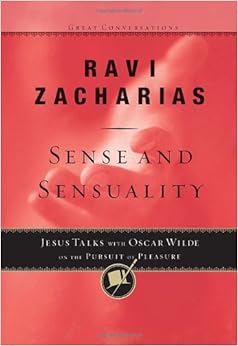 |
| Ravi Zacharias’s Sense and Sensuality |
Imagination courses through the cultural frequency of the generation.
In our day, the idea of the absolute freedom of the artist has gone universal and art is being increasingly detached from moral inhibitions.
Ironically, what comes across as the expression of artistic freedom is often a trade-off between creative autonomy and the established groupthink.
Although freedom is the meme across the creative industries, artists still worry about how they can locate their workflow within the groupthink of the day.
Ben Jonson once said that the principal function of literature is to inform people in the best interest of living.
Such an idea would be detected as anathema in the present context.
The attention now is not so much on the social function or ethical value of art as it is on its aesthetic qualities.
This would seem to be neutral ground for uninhibited creativity but it is not.
The idea of art for art’s sake is at the core of outrageous works which would have been unthinkable in previous ages.
Sex on the screen and profanity on the page have become premium wares, and art, a red light inferno.
More than four hundred years ago, Jonson was already protesting against contemporaries who wrote “with brothelry, able to violate the ear of a pagan, and blasphemy, able to turn the blood of a Christian to water.”
The protest holds in the present context, only to a power incalculable.
The centre has been moved from the responsibility of the artist to society to the delusional groupthink of the artist’s circle.
And, as G.K Chesterton points out: “It’s always easy to let the age have its head; the difficult thing is to keep one’s own.”
A fitting example would be Oscar Wilde, one artist who juggled his life and craft on shifting ground.
Wilde was a hardcore proponent of the Aesthetic Movement which propagated the idea of art for art’s sake, hauling down the long-held conviction that art has a moral or social function.
For a man who regarded his life as a motion picture of his industry, his imprisonment for homosexual offences was the worst occupational hazard.
Wilde processed his downfall in “De Profundis,” a long letter written from prison.
While in prison, his ideas were significantly altered, from a conviction that being lost in pleasure was the only purpose of life to a reflection on suffering as a possible staircase to salvation.
Although Wilde’s dabbling with eternal considerations in the book amount to a vastly
downgraded theology at best, it probably set the stage for his near-death theophany.
Reflecting on Wilde’s spiritual ambiguity, a friend said that the notorious dramatist was always moving backwards to the altar with his eyes on the exit.
“The Ballad of Reading Gaol,” his only work after being released, is, however, more surrendered, soul-deep and agonising.
In “De Profundis,” Wilde testifies, with characteristically inflated self-regard, what he considered to be his cultural assignment.
“I was a man who stood in symbolic relations to the art and culture of my age. I had realised this for myself at the very dawn of my manhood, and forced my age to realise it afterwards,” Wilde wrote, assigning Byron’s symbolic stature lower than his own.
Wilde’s verbal radiance altered the cultural visage of his time, and most artists in our day are proud heirs of his tainted legacy.
Each time we raise our voices for the restoration of original lamp-posts, we are savaged by academic jihadists who were taught that art for art’s sake is the amendment to end all amendments.
Wilde brags, in “De Profundis,” to have equated what is false with what is true as merely variant forms of intellectual existence.
“I treated Art as the supreme reality and life as a mere mode of fiction: I awoke the imagination of my century so that it created myth and legend around me…” he wrote.
Ravi Zacharias takes Wilde’s ideas to their logical conclusions in his 2002 book, “Sense and Sensuality.”
The drama, an imaginary conversation between Christ and Wilde, also features philosopher and father of the modern computer, Blaise Pascal, whose book, “Pensees,” Wilde read while in prison.
Zacharias says that as he read biographies on Wilde, he agonised for him in his struggles, but was also surprised by the sheer folly with which he threw his life away.
“Like an object caught in the tension of two opposing forces, his body and mind were torn between the love of God and the enticement of the sensual,” Zacharias observes.
The play, set in his last hours, opens with Wilde talking to a visiting friend.
A vision comes upon him in which a gardener in the cemetery, who turns out to be Christ, challenges Wilde on his widely publicised views on life and the pursuit of pleasure.
To stay in the range of his panellists’ ideas, Zacharias liberally adapts the words of Christ mainly from the Gospels and the writings of Solomon and Paul; the words of Wilde from his novel, “A Picture of Dorian Gray;” and Pascal’s from “Pensees.”
The action is a Christian flourish to the denouement of “Dorian Gray.”
In the novel, the pleasure-intoxicated young protagonist commissions a portrait of himself and has his wish granted to lose himself in sensuality with the consequent alterations appearing not on him but the picture.
Gray later stabs the artist when the latter reveals to him the atrociously marred portrait, a result of his sensuality, only for blood to gush from the picture. Frantically, he stabs the portrait upon which he falls on the floor lifeless.
At the close of “Sense and Sensuality,” Wilde stabs his own picture only to see that he has stabbed Jesus’ instead, a figure of Christ’s redeeming sacrifice, tying into Wilde’s deathbed conversion.
“This philosophy on art you’re sharing may well be the undoing of any culture. If musicians and artists have no absolutes, they end up caring more about the way the thing is told than about the thing itself, and they slide deeper and deeper till it’s their means rather than the ends that matter,” Pascal at the beginning of their encounter.
He argues that the artist soars to his peak when beauty is bounded by holiness, a view shared by Evelyn Waugh who once said that an artist can do away with God only by making his characters mere abstractions.
“Nothing profane can ever be beautiful… before anything is offered to man, it must first be offered to God. That which God cannot receive because of its vileness must never be offered to a human being for his corruption,” Pascal argues.
Wilde’s mitigation is recessive, being challenged on two fronts.
Underscoring the case for responsibility, “Christ” points out that art “impinges upon the senses as a reality till the lines become blurred between fact and fiction, picture and passion, truth and action, thinking and living.
“A picture takes on a life of its own and sometimes supplants life. Humanity ends up worshiping its own idols and then resembling them,” he says.
Pascal argues that nudity presented as art descralises the purpose for which the body was made since the human heart cannot separate nudity from sensuality and, when that is tried, it reveals not the innocence but the corruption of the heart.
Morality cannot be subservient to beauty, Pascal argues, pointing the other way around as more credible.
“The truth is that whenever a fence is removed, it’s wise to ask why it was put there in the first place… First, a person will victimize himself, then he will victimize others… Ultimately, children will be sacrificed at the altar of a wicked and perverse will,” “Christ”warns.

